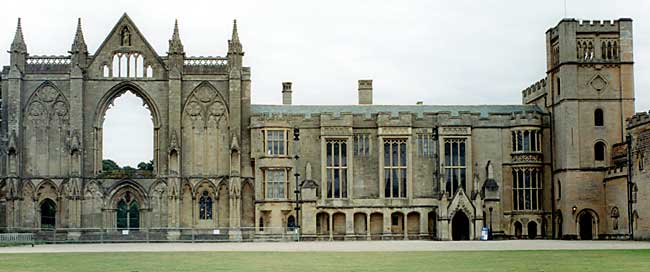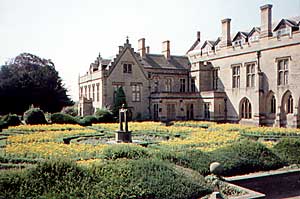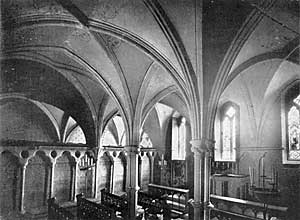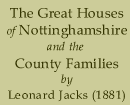< Kirklington | Contents | Norwood >
Newstead Abbey

The West Front of Newstead Abbey. Newstead was founded as a priory of Augustinian Canons between 1163 and 1173 by Henry II. The surviving facade of the priory church dates from the late 13th century. (A. Nicholson, 2003).
PERHAPS no great house has such a wide reputation as Newstead Abbey. Across the Atlantic its associations are in men’s mouths, and Americans coming to England, either on pleasure or business, have found their way to its secluded precincts, have been admitted to its splendid halls, and have been allowed to inspect the few relics that are associated with an imperishable name. They are small things these, but in the eyes of pilgrims, they are covetous possessions, embodying a specific interest, which the Florentine table of Pietra Dura work standing in the grand saloon, and worth a fabulous sum of money, cannot boast. The depositary of the famous skull cup is elegant and beautiful—a rich cabinet of gilt and silver and tortoishell, but this superb shrine would have escaped notice had the goblet itself been preserved. For the vessel had the Byronic stamp upon it; the poet’s lips had touched its rim, and it had contained the Burgundy, which had stirred the blood, and brightened the eyes of the roysterers, whose outrageous mirth has furnished the abbey with a tradition and material for reminiscences that are now eagerly dwelt upon and fully maintained. But the disappearance of the cup has not robbed its owner’s memory of a particle of its spell. There are Byron relics at Newstead to-day, and visitors are freely admitted to their presence. The precious collection is preserved in one of the corridors, or galleries, where the light is abundant. There is the plain circular table on which a portion of " Childe Harold " was composed—the largest of the relics. The others are most of them mere trifles, but possessing an interest which loses nothing of its hold as they get older, dingier, and more insignificant. The spill cups, the unpretentious specimens of crockery ware, the candlesticks, inkstand, swords, singlesticks, boxing gloves, face guards, &c., have but little intrinsic value, but for this miscellaneous collection of old things, which you could almost press into an ordinary clothes basket, there are those who would be glad to give fortunes. The interest which still attaches to the Byron relics might possibly be taken into account in assigning to the dead poet his place in the temple of Fame. The Byron relics occupy but a small space within the walls of Newstead, but they are reckoned among its most precious possessions. Besides those already named, there are "Boatswain’s" collar; carved oak chairs, containing embroidery work, by Lord Byron’s sister Augusta, and the rapier which made the fatal puncture in the body of the hapless Mr. Chaworth. A collection of autograph letters and manuscripts, many of them by the poet, may be numbered among the remains, though they are not generally shown. These have been presented to Mrs. Webb at different times, and, as in the case of the deeds of the Abbey, found in the ball of the brass eagle lectern, which was taken from a pond to which this piece of church furniture has given a name, they are most carefully treasured. They are, however, occasionally brought to light, and were produced for the inspection of Prince Leopold, when that Royal Duke visited the Abbey, in 1881.

The Spanish Garden was designed by Miss Geraldine Webb in 1896. (A. Nicholson, 1997).
The abbey was founded in the twelfth century for the accommodation of a set of canons, and attached to it was a good deal of waste territory in Sherwood Forest, in which Newstead stood. The revenues of the monastery increased during successive reigns, and there is every reason to believe that it was in a thriving, and indeed in a highly prosperous condition at the time of its surrender to Henry the Eighth. In 1540 the abbey was granted to Sir John Byron, Knight, Lieutenant of the Forest of Sherwood, and his heirs, who spent money in destroying its monastic appearance, and converting it into a mansion, suited to the requirements of a sixteenth century country gentleman of wealth and title. The grandson of the first lay owner of Newstead was created a peer in 1643, and his descendent was the author of "Childe Harold" and "Manfred." In the poet’s lifetime, Newstead, which had been in the possession of his family ever since the reign of the Eighth Henry, which had once sustained a seige, and which had often been the scene of great receptions and of courtly assemblies, passed into other hands. It was here that the foundation of that enduring movement of Fame, which Lord Byron has left for the delectation of after generations was laid; it was within this Nottinghamshire house that some of the happiest hours of his life were spent, and the trifles with which he amused himself, and which were about him during the few short years of his residence in this county, are still preserved among the treasures of what was once his home. His attachment to the halls of his fathers may be gathered from the oft-quoted extract from a letter written to his mother, " Come what may, Newstead and I stand and fall together. I have now lived on the spot, I have fixed my heart upon it, and no pressure, present or future, shall induce me to barter the last vestige of my inheritance. I have that pride within me which will enable me to support difficulties. I can endure privations, but could I exchange Newstead for the first fortune in the country, I would reject the proposition." But, mighty as was the affection for ancestral masonry here disclosed, it was destined to dissolve under the application of a pressing and galling necessity. Three years after Lord Byron had assured his mother that he and Newstead should stand or fall together, the home of the illustrious house, of which he was the head, was brought to the hammer. A bid of £90,000 was considered insufficient, and Newstead remained unsold until an offer of £140,000 from Mr. Thomas Claughton made it his property. Lord Byron seems afterwards to have regained possession of the estate, which in 1818 was purchased by Colonel Wildman, who was at Harrow with the poet, for £100,000. On the death of Colonel Wildman, Newstead was again in the market, and at the time it was stated that the Prince of Wales was in treaty for the estate. But whether the sum asked for it was too large for even the Royal Exchequer to disburse, in order to secure an occasional residence, or whether questions of situation and convenience exercised the Royal mind, certain it is that Newstead did not become the residence of a Prince of the Blood. In 1860 Mr. William Frederick Webb became the purchaser of Newstead Abbey, which was sold by private contract. Mr. Webb, the intimate friend of the great traveller, the late David Livingstone, and himself a traveller and sportsman, as many a mighty trophy of plain and jungle, distributed through the spacious halls of Newstead, prove, is the son of Mr. Frederick Webb, of Westwick, Durham, and is the owner of Cawton, in Yorkshire, as well as of Newstead Abbey.
Newstead Abbey has had the good fortune to get into the hands of those whose wealth and taste have enabled them to improve the estate, to maintain the house with becoming splendour, and whose liberality has been wide and generous enough to open its portals to the respectable portion of the public. It is said that the late Colonel Wildman spent £300,000 upon the estate, and the improvement instituted by Mr. Webb, must have involved a very considerable expenditure. As to the interior of the house, a day might well be spent in looking over the contents, which, owing to that afore-mentioned liberality, are familiar to large numbers of people. The floor and walls of the grand saloon are loaded with beautiful things—pictures by Vandyck and Kneller, Lely and Lonsdale on the walls; rare cabinets, enshrining gems of art and vertu, lovely Limoges enamels, a supurb Etruscan vase, placed in an oriel window so that the light may bring out its riches of colour; an ivory chair inlaid with gold, once the property of Warren Hastings; an inlaid table of Italie work, once the pride of an Italian palace, itself worth the price of an estate; and numerous other things of beauty are brought within a closer range of vision. In a corridor outside there are the famous Livingstone relics—the explorer’s cap and consular sword, with a number of weapons from Central Africa, a collection to which Mr. H. M. Stanley has contributed. A Welhingtonia and a Cedrus Atlantica planted in the gardens are pleasing, and it is to be hoped lasting memorials of the visits to Newstead of Livingstone and Stanley, by whose hands they were placed in the soil. There is a room in the abbey—in the Sussex tower, known by the name of the great traveller—a room in which was written that work which has now become a standard one, "The Zambesi and its Tributaries."

The Chapter House was converted into a chapel by the Byrons.
The principal rooms at Newstead, full of interest as they are, need not be described in detail to readers who have been permitted to make themselves familiar with their contents. These are what may be referred to as the historic rooms, which every visitor is allowed to see—rooms in which sovereigns have reposed, rooms that are still haunted by the spirit of the illustrious man of whom Newstead was the cherished home. There is Lord Byron’s bedroom kept undisturbed, with its adjoining dressing room, containing portraits of Joe Murray and of Jackson, the pugilist; a tapestry room, which was once occupied by Charles the Second the Monks’ chamber; the library; King Edward the Third’s bed room; the Duke of Sussex’s room; Henry the Seventh’s lodgings the great dining room, formerly used as a refectory; the breakfast room, formerly the Lord Abbot’s parlour. Then there are the famous cloisters and the elegant little chapel, with its exquisite memorial windows. But the proudest apartment of all is the grand saloon, whose walls are covered with the work of the greatest artists of Europe, and whose smooth floor is the resting place of rare and handsome furniture, including many articles of great value and rare interest, among them enamels by Courtois, Penicault, Limonsin, and Raymond; and cabinets of beautiful and delicate workmanship.
Within the gardens of the abbey there is much to be seen. The beech tree, upon which, in 1814, the poet carved the names of himself and his sister Augusta, was taken down in 1861, when it showed signs of decay, and the piece which bears the precious inscription is carefully preserved among the Byron relics. Boatswain’s monument, with its sublime epitaph, occupies a familiar spot in the quiet, shady gardens; the shrubbery known as "the Monks’ Garden "is allowed to flourish undisturbed; the deep, smooth pond, with it emerald framework, is still fed by springs which are never dry; the "Devil’s Wood" remains one of the darker glories of the grounds; and the Stew Pond, shaded by spreading yews of sturdy growth; the Monks’ Well, with its sweet crystal water; and the great lake, where Mr. Webb casts his flies, give the charm of water to the grounds. Choice plants and rare flowers are cultivated in stovehouse and conservatory, under the care of a gardener who thoroughly understands his business, and luscious fruits are produced for the table of a house which is noted for the sumptuousness of its hospitality.
Newstead has more than once been the scene of Royal visit. The Prince of Wales is familiar with its halls and pleasaunces; the Duke of Albany more recently spent a few pleasant hours among its treasures, with the cultivated society Mr. and Mrs. Webb had gathered about them. The priviliges which Princes have enjoyed is placed within the reach of the humbler classes, and many are the pilgrimages made to Newstead Abbey. Its fall, if ever such a catastrophe was threatened, has been arrested. In the hands of two owners whose wealth has enabled them to maintain its reputation and to introduce costly improvements it has not suffered. Relics of earlier associations have been tenderly preserved. Decay has not been permitted to mar its proportions or to ruin its walls; there is no "fall" for poet to lament in touching strains, and the "blasts of fate" to which it is submitted are light as a summer wind. Newstead is a great house of solid masonry. Order prevails alike within its walls and without, and it belongs to an owner who has done much towards making it what it is.
< Kirklington | Contents | Norwood >
